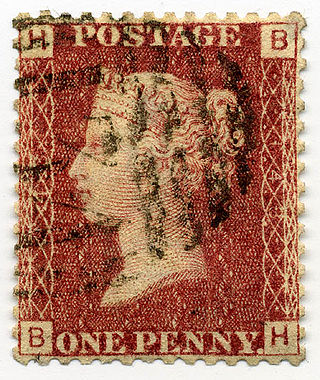
Philately is the study of postage stamps and postal history. It also refers to the collection and appreciation of stamps and other philatelic products. While closely associated with stamp collecting and the study of postage, it is possible to be a philatelist without owning any stamps. For instance, the stamps being studied may be very rare or reside only in museums.
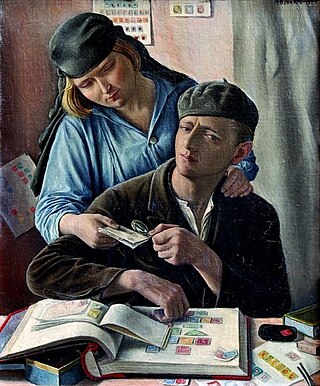
Stamp collecting is the collecting of postage stamps and related objects. It is an area of philately, which is the study of stamps. It has been one of the world's most popular hobbies since the late nineteenth century with the rapid growth of the postal service, as a stream of new stamps was produced by countries that sought to advertise their distinctiveness through their stamps.

Philatelic literature is written material relating to philately, primarily information about postage stamps and postal history.

The Penny Black was the world's first adhesive postage stamp used in a public postal system. It was first issued in the United Kingdom on 1 May 1840 but was not valid for use until 6 May. The stamp features a profile of Queen Victoria.

The Inverted Jenny is a 24 cent United States postage stamp first issued on May 10, 1918, in which the image of the Curtiss JN-4 airplane in the center of the design is printed upside-down; it is one of the most famous errors in American philately. Only one pane of 100 of the invert stamps was ever found, making this error one of the most prized in philately.

The Penny Red was a British postage stamp, issued in 1841. It succeeded the Penny Black and continued as the main type of postage stamp in the United Kingdom of Great Britain and Ireland until 1879, with only minor changes to the design during that time. The colour was changed from black to red because of difficulty in seeing a cancellation mark on the Penny Black; a black cancellation mark was readily visible on a Penny Red.
This is a list of philatelic topics.

The postage stamps and postal system of the Confederate States of America carried the mail of the Confederacy for a brief period in American history. Early in 1861 when South Carolina no longer considered itself part of the Union and demanded that the U.S. Army abandon Fort Sumter, plans for a Confederate postal system were already underway. Indeed, the Confederate Post Office was established on February 21, 1861; and it was not until April 12 that the American Civil War officially began, when the Confederate Army fired upon US soldiers who had refused to abandon the fort. However, the United States Post Office Department continued to handle the mail of the seceded states as usual during the first weeks of the war. It was not until June 1 that the Confederate Post Office took over collection and delivery, now faced with the task of providing postage stamps and mail services for its citizens.

A plate block is a block of stamps from the edge of the sheet which shows the plate or cylinder from which the stamps were printed.

The postage stamps of Ireland are issued by the postal operator of the independent Irish state. Ireland was part of the United Kingdom of Great Britain and Ireland when the world's first postage stamps were issued in 1840. These stamps, and all subsequent British issues, were used in Ireland until the new Irish Government assumed power in 1922. Beginning on 17 February 1922, existing British stamps were overprinted with Irish text to provide some definitives until separate Irish issues became available. Following the overprints, a regular series of definitive stamps was produced by the new Department of Posts and Telegraphs, using domestic designs. These definitives were issued on 6 December 1922; the first was a 2d stamp, depicting a map of Ireland. Since then new images, and additional values as needed, have produced nine definitive series of different designs.

A Presentation Pack typically contains a full set of a new stamp issue, produced for philatelists and stamp collectors. It normally comprises a folded card containing detailed notes about the stamps, a card with clear strips for holding the actual stamps, all held within a clear sleeve. The packs are usually sold at a price a little above the stamps' face value.
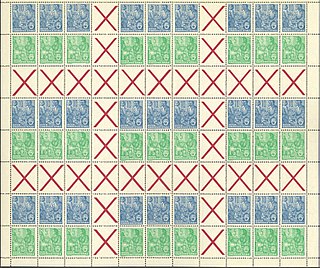
In philately, a gutter is the space left between postage stamps which allows them to be separated or perforated. When stamps are printed on large sheets of paper that will be guillotined into smaller sheets along the gutter it will not exist on the finished sheet of stamps. Some sheets are specifically designed where two panes of stamps are separated by a gutter still in the finished sheet and gutters may, or may not, have some printing in the gutter. Since perforation of a particular width of stamps is normal, the gutter between the stamps is often the same size as the postage stamp.

The postage stamps and postal history of Israel is a survey of the postage stamps issued by the state of Israel, and its postal history, since independence was proclaimed on May 14, 1948. The first postage stamps were issued two days later on May 16, 1948. Pre-1948 postal history is discussed in postage stamps and postal history of Palestine.
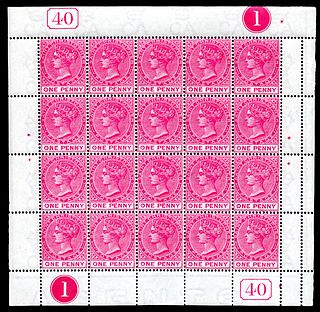
A sheet of stamps or press sheet is a unit of stamps as printed, usually on large sheets of paper based on the size of the printing plate, that are separated into panes that are sold at post offices. Where more than one pane is on a printed sheet they are arranged in a table-like arrangement. The spaces between the single stamps are all of the same size and provide space for a cut or perforation.

A plate number is a number printed in the margin of a sheet or roll of postage stamps, or on the stamp itself, which shows the printing plate used to print the stamps.
A plate number is the serial number of a printing plate. It is printed in the selvage or border of a pane of postage stamps.

Postage stamp paper is the foundation or substrate of the postage stamp to which the ink for the stamp's design is applied to one side and the adhesive is applied to the other. The paper is not only the foundation of the stamp but it has also been incorporated into the stamp's design, has provided security against fraud and has aided in the automation of the postal delivery system.
MS 5236 is an ancient Greek amulet of the 6th century BC, which is unique in two respects: it is the only known magic amulet of the time inscribed with a text that was stamped as opposed to incised, and it is the only extant specimen of ephesia grammata made of gold. The only partially comprehensible inscription is an invocation of the god Phoebus Apollo and may have been composed in central Greece or western Asia Minor. As such magical amulets are known to have been mass-produced, the existence of MS 5236 indicates that, despite the singularity of the foil, an inkless block printing process was practised in ancient Greece to a certain degree, for texts of some length, beyond the examples known from Roman lead pipe inscriptions and the many types of stamps used to mark bricks and pottery with the maker's name and other details.
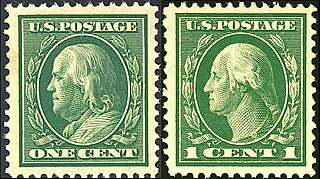
The Washington–Franklin Issues are a series of definitive U.S. Postage stamps depicting George Washington and Benjamin Franklin, issued by the U.S. Post Office between 1908 and 1922. The distinctive feature of this issue is that it employs only two engraved heads set in ovals—Washington and Franklin in full profile—and replicates one or another of these portraits on every stamp denomination in the series. This is a significant departure from previous definitive issues, which had featured pantheons of famous Americans, with each portrait-image confined to a single denomination. At the same time, this break with the recent past represented a return to origins. Washington and Franklin, after all, had appeared on the first two American stamps, issued in 1847, and during the next fifteen years, each of the eight stamp denominations available featured either Washington or Franklin.

The Greek god Hermes, messenger of the Gods in the Greek mythology, is the representation chosen, in 1860, by the Kingdom of Greece to illustrate its first postal stamps.

In philately, label or coupon or tab is a part of sheet of stamps separated from them with perforation. It cannot be used for postage because it does not have face value and any indication of a postal administration that issued such stamps with labels. The notion of label should not be confused with the term "gutter" or with a margin of a stamp sheet.



















